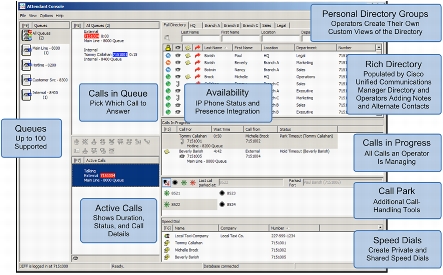
Cisco Unified Attendant Console Advanced
Dispatch Calls Quickly with a Personal Touch
Sorry, this product is no longer available, please contact us for a replacement.
Click here for more options and pricing!
Overview:
Manage high volumes of calls from customers, employees, and business partners smoothly and efficiently. Cisco Unified Attendant Console Advanced (Figure 1) gives corporate operators and receptionists the tools they need to professionally handle incoming calls with ease. Its powerful call queuing engine helps your operators easily manage a high call volume from a variety of sources. The robust directory can handle up to 100,000 contacts and synchronize directly with Microsoft Active Directory. And the optional high-availability feature for the Cisco Unified Attendant Console Advanced server protects your system from downtime.

Figure 1. Cisco Unified Attendant Console Advanced
Cisco Unified Attendant Console Advanced includes a web-based administration utility that guides you through configuring the application server with Cisco Unified Communications Manager. The Cisco Unified Attendant Console Advanced client software is loaded on each operator's desktop PC.
Cisco Unified Attendant Console Advanced pairs with Cisco Unified IP Phones, and is supported on Cisco Unified Communications Manager and Cisco Business Edition 6000 platforms.
Features and Benefits:
Cisco Unified Attendant Console Advanced delivers standard attendant console functions such as call control, searchable corporate directory, speed dials, and busy lamp field. It also provides:
- A powerful call queuing engine that helps your operators easily manage a high call volume from a variety of sources
- A robust directory that can handle up to 100,000 contacts and synchronize directly with Active Directory
- Optional high availability to protect your system from downtime
- Support for up to 50 concurrent users per server
Table lists additional features and benefits of Cisco Unified Attendant Console Advanced.
| Feature | Benefit |
|---|---|
| Queue Features | |
| Support for 100 queues with prioritization | Configure queue names and priorities to match your call answering requirements. You can prioritize and answer calls out of order. For example, you might have a sales queue, a service queue, and a general business queue. Sales calls can be prioritized and answered first, before service or general business calls. |
| Operator queue assignment | In Web Admin, you can assign one or more queues to each operator, allowing you to segment and answer calls based on your business needs. |
| Queue operator views | View all calls within a queue or view all calls within all queues. If operators see many calls in queue, they know that calls need to be processed quickly. If operators see only a few calls in queue, then they can spend more time with each caller to provide a higher level of customer service. If operators see a high-priority caller, they can select and answer calls out of sequence. |
| Overflow options |
You can define overflow settings on a queue-by-queue basis. |
| Queue salutations | Deliver the most appropriate greeting to each caller by setting up a script to be read by the operator for each queue. |
| Different music in different queues | Callers hear music through the Cisco Unified Communications Manager Music on Hold (MoH) function. Cisco Unified Attendant Console Advanced queue device groups let you play different music to different queues. |
| Directory Features | |
| Active Directory or Cisco Unified Communications Manager directory integration | If you use Active Directory to manage your corporate directory, you can synchronize that data directly with the Cisco Unified Attendant Console Advanced directory. Or use Cisco Unified Communications Manager as the directory source. |
| Manually add individual contacts | Operators may add individual contacts directly to their searchable directory for more flexibility. System administrators can also add individual contacts to the full directory with the server's web-based administration tool. |
| Personal directory groups | Each operator can create and share up to 100 custom directory groups, displayed as tabs across the top of the directory. These directory groups are subsets of the full directory, which is synchronized with Cisco Unified Communications Manager. Your operators can create personal directory groups using live directory filters or by dragging and dropping individual contacts. So they can be confident their groups are always up-to-date. |
| Search options | Six directory search fields are provided. They allow the operator to quickly find call destinations and then quickly dispatch calls. Search options include last name, first name, department, extension, job title, and location, and they can be customized within each attendant console client. |
| Presence integration | Operators can view each contact's Cisco Unified Presence status directly from the Attendant Console directory. They can manage calls more efficiently by seeing whether a particular contact is available to take a call. Microsoft OCS 2007 and Microsoft Lync are also supported presence sources in the Attendant Console directory. |
| Telephony Features | |
| Operator handset ringing | When a call comes into a queue configured with operator handset ringing, the call is sent directly to the handset of the operator who has been logged into that queue the longest. This feature lets operators answer the call from a wireless headset while away from their desks. (The wireless headset is not included.) |
| Transfer reversion (call recall) | Enable a transferred call to revert back to the operator so that it can be answered and then transferred to a new destination. |
| Call park | With call park, the operator can place a caller on hold while announcing that a call is on hold and waiting for a particular person or group. The call can be answered from any phone by dialing the park extension. |
| Call park recall | If a parked call is not answered, it reverts back to the operator so that it can be transferred to a new destination. |
| Call toggle | Call toggle allows the operator to shift between callers. |
| Conference | The conference feature allows the operator to provide a third-party conference call. |
| Emergency Mode switch | Redirect all calls to another destination if an emergency such as a natural disaster or weather event occurs. This manual switch lets you stay in touch with callers, or alert them that the business is closed until further notice. |
| Out-of-hours routing | For each queue, define specific blocks of time and where to send calls during that time. Create templates that you can apply to queues. Set up call routing for recurring holidays. |
| Additional Features | |
| High availability (additional license per server) | Use Cisco Unified Attendant Console Advanced high availability to help ensure your operators are always able to take calls. |
| Adjustable font size | Changing the font size is one of the many ways in which individual users can tailor the Cisco Unified Attendant Console Advanced application to best suit their needs. |
| Server-based console preferences | Many of the attendant console client preferences can now follow users to different PCs running Cisco Unified Attendant Console Advanced. |
| Reports | Gain a better understanding of call volumes by operator and queue, the queues that have the most abandoned calls, and other important metrics through attendant console reports. Reports are easily accessible through the web-based administration tool. |
| VMware support | Cisco Unified Attendant Console server is supported in a production environment on VMware ESXi 4.x or 5.0 running on a host machine that is compliant with the Cisco Specifications-Based Hardware Support program. Note: This feature is supported only with Cisco Unified Communications Manager 8.0(1) and later. |
| Accessibility | The visually impaired can use Cisco Unified Attendant Console Advanced because both ZoomText and JAWS scripts are supported. |
| Attendant console client localization | English, French, German, Italian, Portuguese, Spanish, Dutch, Swedish, Danish, Russian, Arabic, Korean, Japanese, Traditional Chinese, and Simplified Chinese are supported. |
Platform Compatibility:
Cisco Unified Attendant Console Advanced Version 10.0 is compatible with Cisco Unified Communications Manager Versions 7.1(5) through 10.0. Cisco Unified Communications Manager Express is not supported.
System Requirements:
Two Tables list the server and client system requirements for Cisco Unified Attendant Console Advanced.
| System Requirements for Cisco Unified Attendant Console Advanced Server | |
|---|---|
| Processor | 2.2 GHz Pentium 4 processor |
| Memory | 4 GB |
| Disk space | 80 GB |
| Networking | Network card, connected to the network using TCP/IP |
| Operating System | One of the following operating systems, with Windows regional settings set to English:
For non-English characters, the relevant language pack for the locale installed |
| Database | One of the following databases:
|
| Notes |
|
Note: The operator client for the Cisco Unified Attendant Console Advanced requires the PC specifications listed in Table 3. You can install Cisco Unified Attendant Console Advanced client software on many PCs, but only up to 50 can be concurrently logged into a server. Refer to the "Ordering Information" section for additional licensing details.
| System Requirements for Cisco Unified Attendant Console Advanced Client | |
|---|---|
| Processor | 2.0 GHz Pentium 4 processor |
| Memory | 1 GB |
| Disk space | 1 GB |
| Hardware |
|
| Operating System | One of the following operating systems:
|
Documentation:
Download the Cisco Unified Attendant Console Advanced Version 10.0 Datasheet (PDF).
Pricing Notes:
- Pricing and product availability subject to change without notice.

